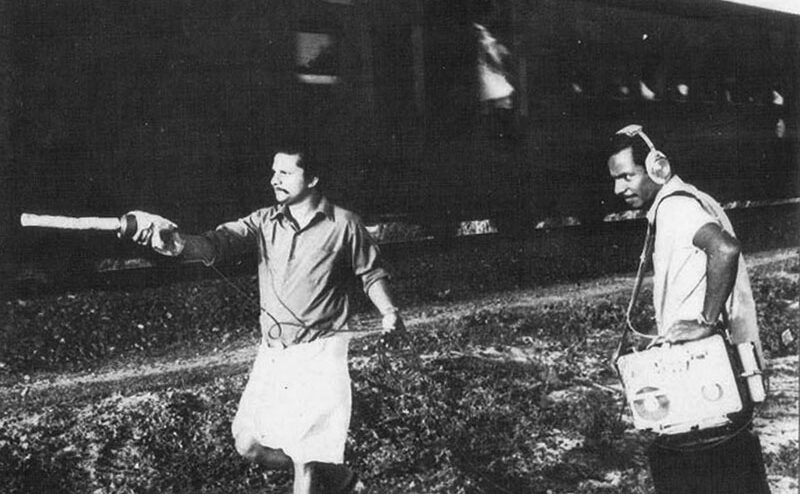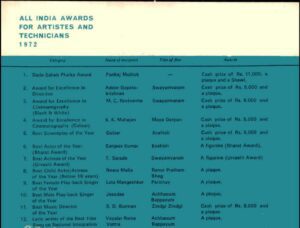A landmark in the history of Malayalam cinema, 'Swayamvaram' was a trendsetter that introduced synchronised sound and outdoor locations.

Director Adoor Gopalakrishnan and audiographer P Devadas recording sound on location during the shooting of 'Swayamvaram'. (Supplied)
It was 24 November, 1972, and a unique experience awaited viewers streaming into all the 14 movie theaters there were then in Kerala.
Drawing them into a 125-minute film was this opening shot, five minutes and 36 seconds long, of an ordinary bus journey in which nothing much happens, with the camera capturing the moods of the unexceptionable passengers.
No other film in Malayalam till date had attempted such an opening shot and approach.
The film was Swayamvaram (One’s Own Choice), and it ushered in the New Wave in Malayalam cinema and announced the arrival of iconic filmmaker Adoor Gopalakrishnan.
The film, considered a landmark in the history of Malayalam cinema, was a trendsetter that introduced the concepts of synchronised sound and outdoor locations, and is still being reckoned with for the experimentation in its narrative style, especially the use of sound and silence
At a time when shooting films on actual locations was unheard of in Malayalam cinema, a young Adoor carried his Nagra recorder and the camera beyond the studio walls.
With Swayamvaram, Adoor showed how real locations and live recording of sound could enhance the overall appeal of a film. He also showed his peers as well as aspiring filmmakers that a film could win laurels without songs, dances and even comedy.
In the words of late P Devadas, who was the audiographer of Swayamvaram, it’s a movie that demands watching as well as hearing.
According to CS Venkiteswaran, a national award winning film critic, Swayamvaram was a path-breaking movie as it defied the narrative and film treatment styles of that time.
Talking to South First, Adoor recalled how the initial response from the theaters was not that promising.
“Immediately after the post-production works, the film was released. But we got a lukewarm response from the 14 theaters in the state,” he said.
It was in July 1973, eight months after the release of the film, that the 20th National Film Awards were announced. Swayamvaram bagged four awards: Best Film, Best Director, Best Cinematography (Ravi Varma) and Best Actress (T Sarada).

The National Awards catalogue of 1973 mentioning the Best Director, Best Cinematographer and Best Actress winners. (Supplied)
“With bold headlines, newspapers carried reports on the award. It was huge publicity. Because of that, interest grew among the people to watch the movie,” said Adoor.
“We once again approached the theaters for a re-release. They were ready to screen it. From then on, the film ran to packed houses for one or two months. I got the amount (invested for the film) back, as well as a profit,” the director, now 81, said.
“The total outlay for Swayamvaram was ₹2.5 lakh. Of that, ₹1.5 lakh was loaned by the FFC (Film Finance Corporation, now known as National Film Development Corporation). The remaining was raised from the marginal profits made from producing documentaries under the banner of Chitralekha Film Cooperative (Kerala’s first such venture, where Adoor was among the founding members),” he said.
“The film was produced by Chithraleha Film Cooperative. The profit gained from this film as well as from Kodiyettam (Adoor’s second film, released in 1977) helped to develop the cooperative. A studio — Chitralekha Studio — came up. Then a black and white lab.”
In his book, ‘Adoor Gopalakrishnan: A Life in Cinema’ (Penguin Random House India, 2017), Gautaman Bhaskaran noted that with all its rehearsals and retakes, Swayamvaram was completed in about 50 days, in two schedules.
According to him, there are many interesting incidents related to the movie, giving it a life of its own — from its inception to its recognition as a major piece of artistic work. He also cited one such incident quoting Adoor.
There was a scene where Adoor planned a rain sequence. But the film was shot during the height of summer. But on that day, as the crew was planning pack-up, rain clouds appeared and suddenly it began raining.
“This was ideal for my visualisation and we quickly shot the scene from all possible angles,” recalled Adoor.
According to Adoor, Swayamvaram is a journey from illusion to reality.
To present an unmarried couple (Viswanathan and Sita played by Madhu and Sarada, respectively) and their decision to live together was a challenge to the existing societal norms.
But they are soon faced with the bitterness of reality and the mundane concerns of day-to-day life. They have to deal with helpers and exploiters, good and bad neighbors, happy and unhappy situations, and others.
Then comes death, taking the breadwinner of the family as Viswanathan succumbs to a fever. He leaves behind his wife Sita and his infant. The film ends with Sita gazing into the camera — at the viewers.
The film leaves viewers with many unanswered questions: Will Sita and her child survive? Will she return to her parents? Or will she take the offer of Viswanathan’s mentor (an accountant at a saw mill) to live with his family? Or will she take to prostitution like her neighbour for a living?
Talking to South First, film critic Venkiteswaran said only a few movies have portrayed love in such a critical and harsh manner.
“The plot of the movie — a couple eloping, hoping to start a new life, the challenges they face — is not something new. It has been said many times before. But what makes it distinct is its approach. The film begins and ends in realism and at no point has it tried to run away from life and its hard realities,” said Venkiteswaran.
It was at the 24th edition of the International Film Festival of Kerala (IFFK) in 2019 that a secret was revealed by Adoor relating to Swayamvaram, 47 years after its release.
Inaugurating the Malayalam Cinema Retrospective that featured films of Sarada, including Swayamvaram, Adoor said that she had caused him trouble when contacted to act in the film.
“After lot of deliberations we it was decided to cast Sarada. We were sure that if Sarada picturised Sita it would be good. We asked our production manager in Madras (now Chennai) to meet Sarada and ask her permission to act in our movie. The manager asked her if she was okay to act in a movie being made by some youngsters. Sarada’s answer was that if she got ₹25,000, she was ready to act. It shocked us. But we gave her the amount she demanded, and she acted,” recalled Adoor.
However, Sarada, who was present on the occasion, said that she did not remember such an incident and apologised to Adoor for the same.
It was in 1965, that Adoor completed script-writing and film direction course at the Film and Television Institute of India (FTII) in Poona (now Pune). A year before that he had done a 20-minute short fiction A Great Day. His first feature film came seven years after he passed out of FTII.
Before winning his first national award, he had scripted and directed 15 documentary films, some of which won awards in India and abroad.
Adoor, who placed Malayalam cinema on the international cinema map, has so far directed 12 films, the last one in 2016 (Pinneyum, or Once Again).
The maestro, who is known for taking long breaks between his movies, told South First that at present he has no story idea in his mind.
“Filmmaking is my life. It is my profession. The plot will come on its own,” said Adoor.
In connection with the 50th anniversary of Swayamvaram, the Department of Cultural Affairs will join hands with the Kerala State Film Development Corporation to release a documentary on the film.
The documentary, The Journey: Swayamvaram at Fifty, will be screened as part of the 45th edition of the Soorya Fest (one of the longest cultural events in India) at Ganesham in Thiruvananthapuram on 25 November at 5.30 pm.
The concept, script, and direction of the documentary are by Madhu Eravankara, an award-winning filmmaker and critic.

Jul 26, 2024

Jul 26, 2024

Jul 25, 2024

Jul 25, 2024

Jul 25, 2024

Jul 24, 2024